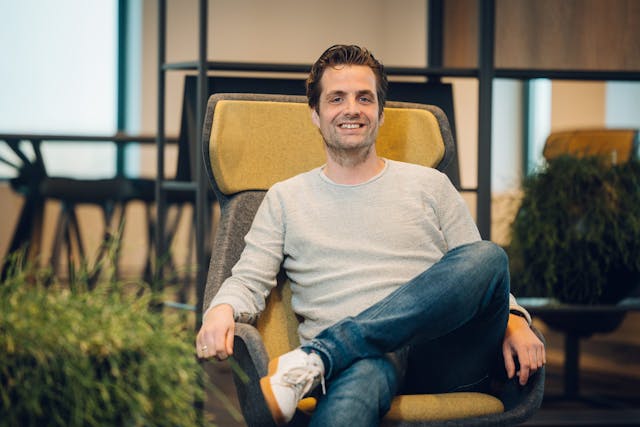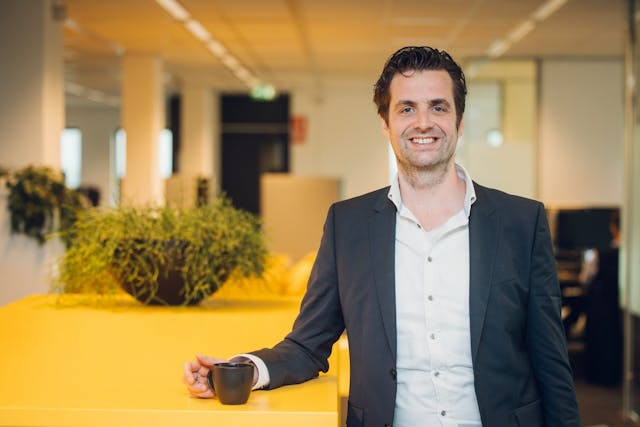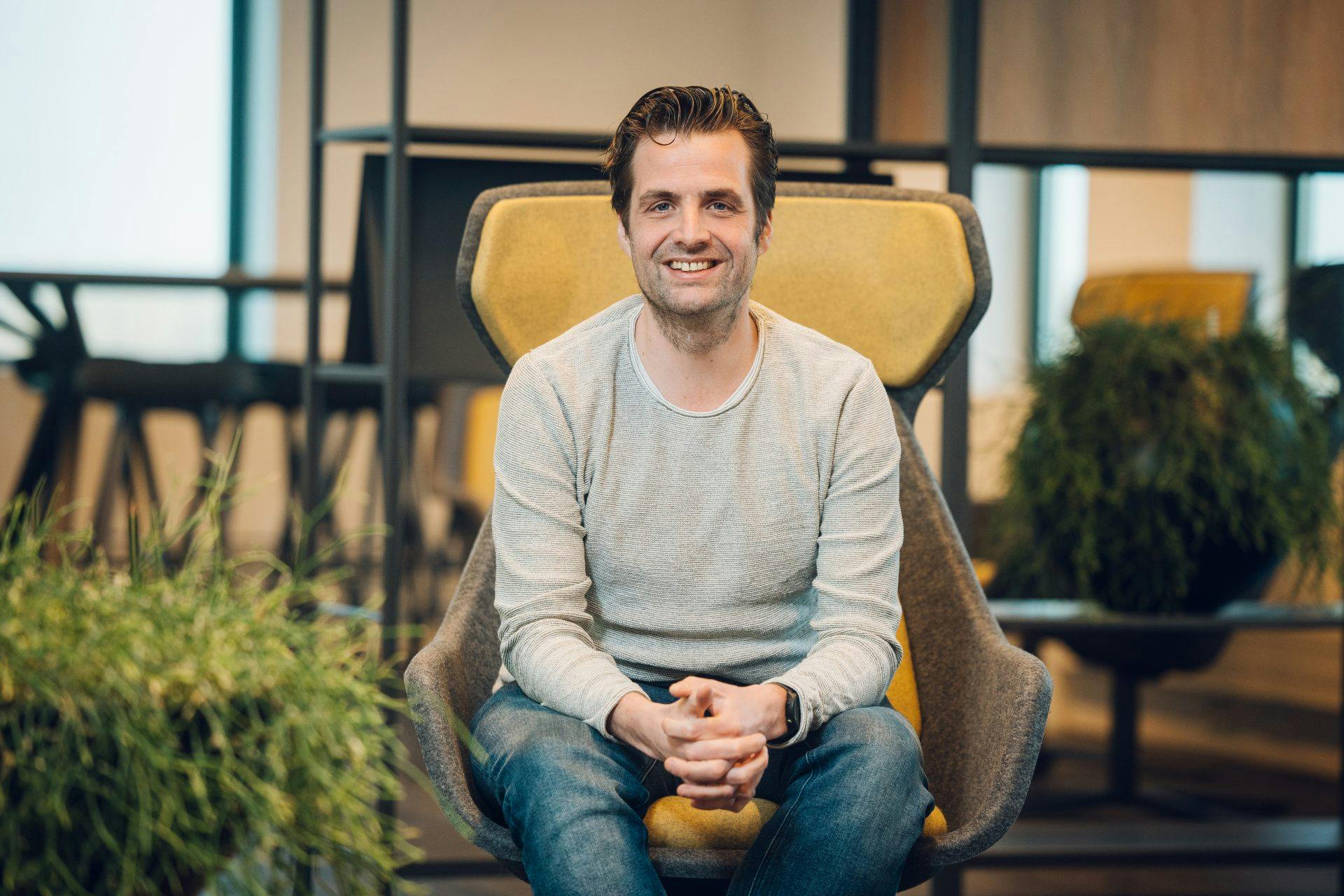Logistics Leadership: Agility and Digital Transformation
Read time: 8 minutesUnpredictable customer expectations, complex supply chains, and unexpected disruptions demand more from companies than just a streamlined logistics process. Those who want to thrive in this dynamic environment must learn to plan for the unexpected, flexibly anticipate different scenarios, and switch gears in real time. Frans van Helden, EVP Supply Chain Planning at ORTEC, believes that organizations must now demonstrate strategic leadership: “The future calls for flexibility and smart choices.”
A conversation with Frans van Helden, EVP of ORTEC Supply Chain Planning

According to Van Helden, it is essential for companies to be aware of their own logistics maturity and take targeted steps based on that insight. ORTEC supports organizations at all stages of development – from frontrunners with tight processes and advanced data flows to companies that operate well but are still searching for more structure and efficiency. “What all these companies have in common,” he says, “is the ambition to become smarter, more predictable, and more efficient. That requires not only powerful software but, above all, insight into how to smartly combine technology and processes into a robust and future-proof logistics system.”
The role ORTEC plays in this is not just about serving a ready-made solution. ORTEC uses a structured approach, outlined in the Logistics Management Maturity Model – a framework that maps the growth phases of logistics maturity. The model distinguishes five stages: from ad hoc operations where putting out fires is the norm, to advanced supply chain management where companies seamlessly orchestrate both their own processes and those of their partners. “If you strip it down to the essentials, our offering is more than software alone,” emphasizes Van Helden. “It’s a journey to better logistics management.” And that journey can look different for everyone.

Frans van Helden, Executive Vice President Supply Chain Planning
"That requires not only powerful software but, above all, insight into how to smartly combine technology and processes into a robust and future-proof logistics system."
The Logistics Management Maturity Model
The Logistics Management Maturity Model provides a structured path to develop logistics operations from reactive chaos to strategic supply chain management. The model consists of five phases in which organizations grow step-by-step toward logistics maturity:
- Phase 1: Live to Fight Another Day
Characteristic: Reactive firefighting mode with low performance and little visibility.
Goal: To create stability by addressing immediate problems and setting up basic processes. - Phase 2: Foundational Work
Characteristic: Focus on automation and data collection to lay a solid foundation.
Goal: To increase efficiency by streamlining processes such as order entry and capturing essential logistics data. - Phase 3: Seize Control
Characteristic: Internal control with real-time visibility and strategic measurements.
Goal: To manage proactively, through tools like a Control Tower and improved collaboration between departments. - Phase 4: Optimize on Own Scope
Characteristic: Data-driven optimization of internal processes such as routing and customer prioritization.
Goal: To achieve measurable progress through targeted improvements within one’s own operation. - Phase 5: Orchestrate Across Partners
Characteristic: Full integration with external partners for an efficient logistics network.
Goal: To increase agility and sustainability through chain-wide collaboration and visibility.
"What all these companies have in common is the ambition to work smarter."
- Frans van Helden, EVP Supply Chain Planning
A key enabler in that journey is ORTEC’s software, a SaaS solution that helps companies plan, execute, and monitor their logistics processes. The system is powerful and versatile, with modules covering everything from route optimization to real-time tracking. But Van Helden is clear: “The software is a tool – not an end in itself. What really matters is how organizations use that software, along with changes in their processes and mindset.”
In practice, Van Helden often sees that companies only utilize parts of the full potential in the first months after implementation. “We start with the basics. In most of our implementation projects, a lot of value is already yielded by the data analysis prior to creating the first optimized routes and loads. Using that data analysis we start making optimized plans and setting routes.” Once the initial implementation phase is over, the return can be even greater, he explains. “That happens when processes are revised, when teams gain new insights from the data, and when there is a continuous interaction between people, systems, and operations.”

Frans van Helden, Executive Vice President Supply Chain Planning
"The real return comes when teams turn data into insights."
From Optimizing to Orchestrating
Van Helden observes a clear evolution among ORTEC’s customers. Whereas in the past their main goal was getting their own operations under control – such as deploying trucks more efficiently or reducing empty miles – the focus is increasingly shifting to collaboration in broader networks, as many companies tap into the distribution capacity of their suppliers. “Companies not only want to optimize, but also to orchestrate,” he says. That means aligning their own processes with those of suppliers, distributors, and even end customers.
This shift requires a different approach, especially since B2B and B2C logistics each have their own dynamics. “In B2C, it’s about speed and visibility; the consumer wants to know where their package is. Moreover, the logistics is characterized by high density; you should be able to deliver anywhere. In B2B, it’s often about scale and complexity. Deliveries are larger, and both the chains and the distances are longer,” explains Van Helden. “That makes for complex networks. Additionally, you have to deal with customer contracts. In short, the differences are significant. That’s why we focus on industries where our expertise in complex planning adds the most value – think retail, manufacturing, and energy industries.”
This sector-specific focus is no coincidence. It enables ORTEC to build in-depth domain knowledge, something Van Helden considers essential. “You can’t offer a generic solution for a specific problem. If you really want to make an impact, you need to speak your customer’s language and understand the nuances of their operation.”
But there’s more than just sector-specific knowledge. Van Helden has a broader vision on how companies should look at the future. “We often talk about the future as if it’s a linear extension of the past, as if it’s just the past that still has to happen,” he says. “But the future is not a straight line. There are always multiple possible scenarios. And when you make plans, you have to take that into account.”
To tackle that uncertainty, ORTEC combines the classic Plan-Do-Check-Act principle with advanced forecasting models. These models map not one future, but several: a Plan A for the most likely scenario, a Plan B for a plausible alternative, and a Plan C for unexpected twists. “It gives customers both control and agility,” says Van Helden. “These days, that’s worth its weight in gold.”
"With a robust plan that’s a bit less tight but can take a hit, you prevent one disruption from immediately affecting the entire system.”
- Frans van Helden, EVP Supply Chain Planning
Accounting for the Human Factor
But even the best plans will clash with daily practice. “You can map out a beautiful route with perfect timing and minimal costs, but if a driver has to pay tolls out of his own pocket, he’ll just choose another road. And rightly so.”
Employees are not robots, Van Helden points out. “They make decisions based on their practical experience – and these often make a lot of sense from their point of view. Think of a driver who first visits a customer where he knows he’ll get a cup of coffee, instead of following the route prescribed by the system. Or a colleague who swaps deliveries because his truck is too full and he knows another driver has space left. And with a growing shortage in drivers, being aware of these things may actually be smarter from a business perspective as well.” Those kinds of choices are human and often well-intentioned, says Van Helden. “But they can have significant consequences for the entire logistics system: from extra costs to delays.”
These are striking examples of how human behavior and unforeseen circumstances can challenge even the most advanced systems. That resilience is exactly why ORTEC focuses not just on planning, but also on monitoring. The SCP solution not only takes into account the big picture, but also provides real-time visibility into what actually happens on the road: from route deviations to delivery delays. “It’s about learning from what you see in execution,” explains Van Helden. “You bring those insights back to your planning process. Why do certain routes consistently deviate? Why do deliveries on a specific route keep getting stuck? If you know that, you can make targeted improvements.”
If you incorporate those insights into planning, the process becomes not only more realistic but also more robust, as Van Helden emphasizes. “That means, for example, that you don’t just work on the most efficient plan but also leave room for flexibility. With a robust plan that’s a bit less tight but can take a hit, you prevent one disruption from immediately affecting the entire system.”

Frans van Helden, Executive Vice President Supply Chain Planning
"A good system looks ahead and provides options."
Dynamic Planning
That need for robustness and flexibility brings us to another crucial point: dynamic planning. In a time when labor shortages, rising costs, and high expectations for delivery reliability are the norm, static planning is no longer an option. “If you want to deploy your employees flexibly, you also need to be able to plan them flexibly,” says Van Helden. “And that requires two things: good forecasts and systems that can handle those dynamics.”
ORTEC’s SCP solution is built for that. The system can make real-time adjustments based on changing circumstances – a sick driver, an unexpected traffic jam, a last-minute order. But it starts with the basics: reliable data and smart algorithms that work not only reactively but also proactively. “A good system helps to look ahead,” says Van Helden. “It gives insight into what might happen and gives you options to respond to it.”
That dynamic has operational benefits, but also human ones. “A robust planning process that takes your employees into account increases their engagement,” he explains. “When people see that their input is taken seriously, they feel more ownership of their work. That reduces turnover and increases satisfaction. It’s a win-win.”
The Role of Visibility in Data Refinement
Real improvement starts with insight. “Planners and logistics employees can only seize such opportunities if they are aware of them,” says Van Helden. “And you create that awareness by presenting data well – not in an endless Excel list, but in a visual context. A map where you can actually see where the trucks are driving, where delays occur, where deviations are. Then you suddenly see where something is happening, and you can intervene in a targeted manner.” A visual context is much more intuitive than a list of data and is also easier to use.
A key component in that approach is visibility – the ability to see what’s happening in real time. “If you see on a map that a truck stops just next to the customer, you can check if your location data is correct,” says Van Helden. “You would never have seen that using just raw data.” Those insights are not only useful for operational decisions, but also for data quality. “The more you see, the better you can refine your system,” he explains. “It’s a cycle of improvement.”
"The more you see, the better you can refine your system. It’s a cycle of improvement."
- Frans van Helden, EVP Supply Chain Planning
Saving Costs, Increasing Satisfaction
If we take a step back and look at why customers choose ORTEC, one motive often surfaces: cost savings. “Most projects start with a clear business case around cost savings,” Van Helden says. “But what companies do with those savings varies greatly. Some put it directly into their bottom line – more profit, happier shareholders. But others invest it in customer satisfaction or sustainability, and that often pays off more in the long term.”
He gives a concrete example: “We are working with a client on a large project where cost reduction is the first objective. But when you talk to them, you notice that the real aspiration is deeper: they want to significantly improve their Net Promoter Score (NPS). They do this by guaranteeing reliable delivery times and providing more visibility to their end customers. That client wants its customers to know exactly when their delivery is coming. That increases satisfaction, and that’s what it’s ultimately about. As they themselves put it: they want the cost savings from the first phase of the project to pay for the rest of the objectives.”

Frans van Helden, Executive Vice President Supply Chain Planning
"There’s a growing realization that logistics is crucial for strategic success."
Sustainability and Complexity: A Shifting Focus
Sustainability is another theme that is becoming increasingly prominent. “It is more often explicitly mentioned as a driver,” says Van Helden. “And that often overlaps with cost savings: shorter routes, fewer kilometers – that’s good for your wallet and the environment.” But sustainability also brings new challenges. Think of deliveries with electric vehicles, which have shorter ranges and require charging times. “That requires different routes and different planning, and your system must be able to handle those restrictions,” he explains.
The message is clear: a good logistics system is not just efficient for today, but also flexible enough for tomorrow’s reality.
In the past, costs were often the only motivation, but Van Helden sees a shift. “There’s a growing realization that logistics is crucial for strategic success,” he says. “Delivery reliability, customer expectations, sustainability goals – it all comes together in the supply chain.” Thanks to technological advancements – from AI to real-time data – the possibilities are greater than ever. But that also puts pressure on companies. “All those technological possibilities are useless if you can’t put them into practice. So that’s the first challenge. And you can’t wait too long: those who are lagging now won’t catch up easily,” he warns. “You can’t say: I’ll just open a big bag of money later and everything will be fixed. Digital lag runs deep – in your software, your processes, your data, your mindset.”
And that lag has consequences. “You lose talent, you miss innovative ideas, you become less attractive to customers and partners,” says Van Helden. “You can structurally fall behind – and you can’t close that gap all at once.”
The Future Demands Leadership
Van Helden concludes: “Consumers demand convenience and transparency – that trickles down to logistics management as well. Planners who tackle complex situations instead of shuffling things in Excel make the difference. Logistics leadership means investing in agility, closing the digital gap, and being prepared for what’s coming. Because in this race, your supply chain determines whether you lead or lag. And standing still is not an option. The supply chain defines what your customers receive and see from your company – it is the reality that needs to live up to the promise of your brand.”
About Frans van Helden
As the Executive Vice President (EVP) of Supply Chain Planning division within ORTEC, Frans's overarching goal is to exceed client expectations by continuously delivering tangible and enduring value. His commitment to diversity and the integration of technology into business processes stands out, highlighting a forward-thinking and client-centric leadership approach. By making ORTEC’s software offering more scalable and deepening the portfolio in alignment with ORTEC’s continuous improvement philosophy, Frans anticipates a substantial expansion within the next few years in the Americas as well as in Europe.

Smart Decisions Start with the Right Insights
Stay informed with expert insights, industry trends, and practical strategies that help you stay ahead. Subscribe now to get the latest updates straight to your inbox.